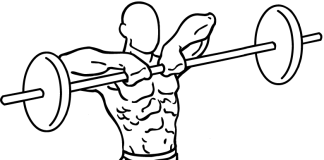Last Updated on September 20, 2014
The “Superman” exercise is a simple yet powerful move that targets the lower back, glutes, hamstrings, and core. Named for the position that resembles a flying superhero, this exercise is especially beneficial for those looking to improve posture, alleviate lower back pain, and enhance core stability.
In this comprehensive guide, we’ll explore everything you need to know about the Superman exercise: its benefits, proper technique, common mistakes to avoid, and variations that can help you progress.
Benefits of the Superman Exercise
- Strengthens Lower Back Muscles: The Superman exercise targets the erector spinae muscles, which run along the spine and play a critical role in supporting your back and maintaining an upright posture.
- Improves Core Stability: By engaging the core muscles, Supermans help build a stable core, which is essential for nearly all forms of physical activity and for maintaining balance.
- Engages Glutes and Hamstrings: While primarily known as a back exercise, the Superman move also activates the glutes and hamstrings, creating a balanced approach to lower body strength.
- Enhances Posture: Strong back muscles can counteract the effects of sitting for extended periods, which often leads to rounded shoulders and forward head posture.
- Reduces Lower Back Pain: Strengthening the muscles around the spine through exercises like Supermans can help prevent lower back pain and even alleviate existing discomfort.
How to Perform the Superman Exercise: Step-by-Step Guide
Step 1: Setting Up
- Lie Face Down: Begin by lying flat on your stomach on a comfortable surface, such as an exercise mat. Extend your arms forward with your legs fully stretched out behind you. Your body should be in a straight line, with your arms and legs relaxed on the floor.
- Head Position: Keep your head in a neutral position, looking down. Avoid straining your neck by lifting your chin or looking forward.
Step 2: Engaging the Muscles
- Core Engagement: Before lifting, engage your core muscles by gently drawing in your belly button toward your spine. This helps protect the lower back and keeps the movement controlled.
- Squeeze the Glutes: Contract your glutes and hamstrings, which will help lift your legs and support your lower back during the exercise.
Step 3: Lift Arms and Legs Simultaneously
- Raise Arms and Legs: Slowly lift both your arms and legs off the floor simultaneously, aiming to raise them a few inches. Imagine reaching forward with your fingertips and backward with your toes to create length in the body.
- Avoid Overarching: Lift only as high as comfortable, keeping your movements controlled. Avoid overextending or arching your back, as this could strain the lower spine.
Step 4: Hold the Position
- Pause and Squeeze: Hold the raised position for about 2-5 seconds, squeezing the glutes, lower back, and shoulders. This pause intensifies the contraction, building strength in the targeted muscles.
Step 5: Lower Back Down
- Controlled Descent: Slowly lower your arms and legs back down to the starting position, keeping tension in the muscles.
- Repeat the Movement: Aim for 2-3 sets of 10-15 repetitions, depending on your fitness level. Quality of movement is key, so prioritize form over the number of reps.
Tips for Maximizing the Effectiveness of Supermans
- Focus on Form: Proper form is essential for reaping the benefits of the Superman exercise. Lift only to the point where you feel a good contraction in the lower back and glutes.
- Engage Your Core: Keeping the core engaged supports the lower back, making the exercise safer and more effective.
- Breathe: Exhale as you lift your arms and legs and inhale as you return to the starting position. Steady breathing can help you maintain control throughout the movement.
- Use a Mat: Performing the Superman on a soft exercise mat reduces pressure on the hips, chest, and knees, making the exercise more comfortable.
Common Mistakes to Avoid
- Overarching the Lower Back: Lifting too high can place unnecessary strain on the spine. Focus on controlled, moderate lifts rather than height.
- Holding Your Breath: Many people forget to breathe during core exercises. Maintain a steady breath, which will support core stability and help prevent strain.
- Fast, Jerky Movements: Supermans are most effective when performed slowly and steadily. Jerking or using momentum reduces muscle activation and increases the risk of injury.
- Not Engaging the Glutes: The glutes support the lower back in this exercise, so make sure they’re engaged as you lift. This also enhances the overall effectiveness of the movement.
- Incorrect Head Positioning: Looking forward instead of down can lead to neck strain. Keep your gaze down, and let your head follow the line of your spine.
Variations of the Superman Exercise
For those ready to progress or modify the Superman exercise, try these variations to target different muscle groups or increase the challenge.
1. Alternating Superman
- How to Do It: Instead of lifting both arms and legs simultaneously, alternate by lifting your right arm and left leg, then switch to your left arm and right leg.
- Benefits: This version is easier on the lower back and engages the core more intensively as it requires balance and coordination.
2. Superman with Dumbbells
- How to Do It: Hold a light dumbbell in each hand as you perform the lift. Keep the weight light to avoid straining your shoulders and lower back.
- Benefits: Adding resistance increases the difficulty and further strengthens the shoulders, back, and glutes.
3. Swiss Ball Superman
- How to Do It: Position yourself face down on a Swiss ball with your chest on the ball and feet planted on the floor. Extend your arms in front of you and lift as you would in a standard Superman.
- Benefits: The Swiss ball adds an element of instability, requiring more core activation and improving balance.
4. Extended Hold Superman
- How to Do It: Hold the raised position for an extended period, such as 10-15 seconds, before lowering. You may need to reduce the number of reps to avoid fatigue.
- Benefits: Extended holds build muscular endurance in the lower back and glutes, making it an excellent option for those aiming to improve stamina.
5. Superman with Arm and Leg Circles
- How to Do It: After lifting into the Superman position, perform small circles with your arms and legs before returning to the starting position.
- Benefits: The added movement enhances core stability and engages the muscles in new ways, promoting greater overall strength and endurance.
Integrating the Superman Exercise into Your Routine
- Warm-Up: Include the Superman exercise as part of your warm-up on back or core-focused workout days. It helps activate the muscles you’ll be working and warms up the lower back.
- As a Core Exercise: Use it as a core stabilization move to help strengthen the deep muscles of the torso.
- For Posture Improvement: Pair Supermans with other posture-improving exercises like rows, face pulls, and planks to counteract the effects of sitting and enhance overall posture.
- In a Finisher Circuit: Add the Superman to the end of a workout as part of a core or lower back finisher to engage those muscles before wrapping up.
Muscle Anatomy and Mechanics: Why Superman Works
The Superman exercise is primarily a posterior chain exercise, targeting muscles along the back side of your body. These include:
- Erector Spinae: The long muscles running parallel to the spine. Strengthening these muscles promotes a healthy spine and helps reduce back pain.
- Gluteus Maximus: The glutes play a supporting role, especially when lifting the legs off the ground.
- Hamstrings: This exercise activates the hamstrings as they help lift the legs off the floor.
- Deltoids and Trapezius: Lifting the arms engages the shoulders and upper back, particularly the posterior deltoids and traps.
The activation of these muscles builds functional strength that supports daily activities, like lifting and bending, and improves athletic performance.
Frequently Asked Questions
1. How often should I do the Superman exercise?
- For general strength and posture, 2-3 times a week is effective. If you’re using it to manage lower back pain, consult a professional for guidance.
2. Is the Superman exercise safe for everyone?
- Generally, yes, but those with existing back conditions should seek advice from a healthcare provider before beginning.
3. What if I feel strain in my lower back?
- If you feel strain, try lifting less or performing the Alternating Superman variation, which is gentler on the lower back.
The Importance of Strengthening the Posterior Chain
A strong posterior chain helps prevent injuries, improves posture, and enhances athletic performance. Most people tend to focus on the muscles in the front of the body, leading to imbalances that can cause poor posture and increase the risk of injury. Supermans help to address this imbalance by focusing on the muscles along the back of your body, providing a balanced approach to strength and stability.
Wrapping Up: Superman for a Stronger, Healthier Back
The Superman exercise is an accessible yet effective movement for strengthening the lower back, glutes, hamstrings, and core. Its simplicity makes it suitable for all fitness levels, while its effectiveness provides a solid foundation for more advanced core and back exercises. Whether you’re aiming to alleviate back pain, improve posture, or enhance overall core stability, adding Supermans to your routine can bring numerous physical benefits.
By following the correct form, engaging the right muscles, and avoiding common mistakes, you’ll be able to make the most of this exercise. Remember to start slow, focusing on the quality of each movement rather than quantity. As you progress, try incorporating some of the variations for an additional challenge and to keep your workouts interesting and engaging.
Adding Superman exercises to your weekly fitness regimen is a simple step that can make a big difference in your posture, core stability, and lower back strength—building a foundation for better performance in both your daily activities and athletic pursuits.








